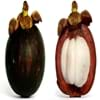Health Benefits
Good for diabetics, Improves well-being, Miraculin/miracle fruit makes sour things taste sweet
Arthritis treatment, Cancer prevention, Increases metabolic rate, Kidney stone treatment, Lower blood pressure, Prevents constipation, Prevents diabetes, Strengthening of bones, Ulcer treatment, Weight loss properties
General Benefits
Has taste modifying effect
Boosts immune system, Controls blood pressure, Digestive aid, Improves eye vision, Maintains healthy cholesterol level
Skin Benefits
NA
Anti-aging benefits, Brightens and lightens complexion, Hydrates skin, Skin rejuvenation, Treatment of acne, Treatment of dark spots
Hair Benefits
NA
Good conditioner, Prevents hair loss, Regulates hair growth, Treatment of dandruff
Allergy Symptoms
Itching, Skin rash
Abdominal pains, Breathing difficulty, Coughing, Diarrhea, Drop in blood pressure, Fainting, Runny nose, Skin rash, Sneezing, Swelling of mouth, tongue or lips, Vomiting
Side Effects
Changes taste of food eaten after this fruit, Coagulation
Abdominal cramps, Diarrhoea, Weight gain
Best Time to Eat
As a snack in the late afternoon, Eat the fresh ones, avoid mixing with any other foods, don't eat after meal., Morning time (before lunch)
As a snack in the late afternoon, Don't consume at night and before bed, Eat the fresh ones, avoid mixing with any other foods, don't eat after meal., Morning time (before lunch), Strictly avoid empty stomach
Protein to Carb Ratio
Not Available
Vitamin A (Retinol)
Not Available
Vitamin B1 (Thiamin)
Not Available
Vitamin B2 (Riboflavin)
Not Available
Vitamin B3 (Niacin)
Not Available
Vitamin B5 (Pantothenic Acid)
Not Available
Vitamin B6 (Pyridoxin)
Not Available
Vitamin B9 (Folic acid)
Not Available
Vitamin C (Ascorbic Acid)
Vitamin K (Phyllochinone)
Not Available
Lutein+Zeaxanthin
Not Available
Water Content
Not Available
Calories in Fresh Fruit with Peel
Not Available
Calories in Fresh Fruit without Peel
Not Available
Calories in Frozen Form
Not Available
Calories in Dried Form
Not Available
Calories in Canned Form
Not Available
Calories in Juice
Not Available
Calories in Jam
Not Available
Calories in Pie
Not Available
Varieties
Gymnema Sylvestre and Thaumatococcus Daniellii
Sweet Orange - Persian orange, Navel orange, Valencia orange and Blood orange. Sour Orange - Seville orange, Bergamot orange, Chinotto orange and Daidai.
Inside Color
Greyish-white
Orange
Taste
NA, Sweet
Sweet-Sour
Origin
West Africa
South-Eastern Asia
Soil Type
Well-drained
Loam, Sandy loam
Climatic Conditions
Rainfall
Hot
Facts about
- The name 'Miracle' because of the magical experience you get after eating it.
- When you have lemon after eating this fruit, it tastes sweet as if it is added with sugar.
- It is also used as natural sweetener.
- There are around 600 varieties of oranges available worldwide.
- More than 1 plant can grow from a single orange seed.
- Orange and orange blossoms are a symbol of love.
- Orange tree is usually propagated by grafting.
Other Countries
NA
China, Egypt, India, Italy, Mexico, South Africa, Spain, Turkey, United States of America
Top Importer
Not Available
Germany
Top Exporter
United States of America
Spain
Botanical Name
Synsepalum Dulcificum
Citrus sinensis
Synonym
Miracle Berry, Miraculous Berry and Sweet Berry
Citrus aurantium L. var. dulcis
Subkingdom
Tracheobionta
Tracheobionta
Division
NA
Magnoliophyta
Subclass
Asteridae
Rosidae
Order
Ericales
Sapindales
Family
Sapotaceae
Rutaceae
Species
S. dulcificum
C. × sinensis
Generic Group
Not Available
Citrus fruit
Difference Between Miracle fruit and Orange
We might think that Miracle fruit and Orange are similar with respect to nutritional value and health benefits. But the nutrient content of both fruits is different. Miracle fruit and Orange Facts such as their taste, shape, color, and size are also distinct. The difference between Miracle fruit and Orange is explained here.
The amount of calories in 100 gm of fresh Miracle fruit and Orange with peel is Not Available and 63.00 kcal and the amount of calories without peel is Not Available and 47.00 kcal respectively. Thus, Miracle fruit and Orange belong to Low Calorie Fruits and Low Calorie Fruits category.These fruits might or might not differ with respect to their scientific classification. The order of Miracle fruit and Orange is Ericales and Sapindales respectively. Miracle fruit belongs to Sapotaceae family and Orange belongs to Rutaceae family. Miracle fruit belongs to Synsepalum genus of S. dulcificum species and Orange belongs to Citrus genus of C. × sinensis species. Beings plants, both fruits belong to Plantae Kingdom.









